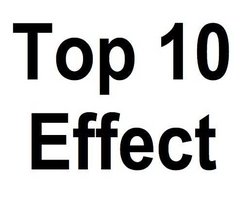A new US study suggests that consumers pay attention to the “Top Ten Effect,” for instance when picking a college, restaurant, hotel or doctor.
Researchers demonstrated that numbers of college applicants increase significantly when a college moves ranking from just outside to just inside a Top 10, or Top 25 list.
Writing about their work (“The Top-Ten Effect: Consumers’ Subjective Categorization of Ranked Lists”) in a recent online issue of the Journal of Consumer Research, authors Mathew S. Isaac of Seattle University, and Robert M. Schindler of Rutgers University, conclude that colleges already well positioned in a top 10 or top 25 ranking list would not get as much value for money in terms of attracting applicants by trying to move up the list compared to colleges who are trying to get onto the list.
In other words, if a college is already at say 7 or 8 in the Top Ten ranking, then it will see less return on effort from trying to push up to 5 or 6, than one that is at 11 or 12 that manages to push its ranking up to 9 or 10.
The authors write:
“We tend to hear people talking about ‘Top 10’ or ‘Top 25’ lists. Our impressions were that there might be an exaggerated difference in how something is perceived when it is on opposite sides of what we call category borders (for example, between 10 and 11 or 25 and 26).”
College applicants use ranking lists in their decision-making
In their introduction they describe how our Western culture is full of examples of ranked lists, like Bloomberg Businessweek’s rankings of MBA programs, and how consumers often use them in decision-making.
Lists of ranked items are ubiquitous in Western culture.
They sought to explore this further by running a series of experiments where they showed participants ranked lists of consecutively numbered items, and found they mentally subdivided the lists into smaller subsets, and exaggerated the differences between consecutive items around certain boundaries.
Also, contrary to previous studies that suggest people tend to consider place-value categories (for instance, single digits, the twenties), they found that participants interpreted ranked lists by generating round numbers ending in zero or five (as in Top 10, or Top 25).
The researchers argue that college applicants will perceive a move in rank that crosses a round number category boundary (such as from position 11 to 10 on the list) as a better improvement in ranking than a move that does not cross the boundary (such as from 10 to 9).
They conclude:
“This phenomenon, labeled the top-ten effect, occurs because round numbers are cognitively accessible to consumers due to their prevalent use in everyday communication.”
In part of the study, where they showed how this effect may influence how people pick a business school, they used data from the Graduate Management Admissions Council on nearly half a million people who took the GMAT exam over a three-year period.
The GMAT exam is a standardized test of quantitative, verbal, analytical and integrated reasoning skills, that many business schools around the world offering MBAs, Masters in Accountancy, Finance, and so on, require college candidates to take as part of the application process.
The researchers then matched the exam dates with the business schools the candidates wanted their exam results sent to – they said this was a good indication of the schools they intended to apply to.
The researchers then compared this with each school’s ranking for each of the three years in the annual US News & World Report list.
They found that if a business school’s position on the list passed a round-number boundary (such as moving from 12 to 10, or from 26 to 24), this was linked to a significant increase in the number of applications to the school for the year the change took place.
Thus the researchers argue that:
“An organization whose products and services are subject to third-party ranked lists should invest more aggressively in improving its rank if it is just on the outside looking in to a round-number category. By contrast, a similar rank-increasing effort by an organization that is already ranked number 9 or number 24 might not provide cost-effective results.”


